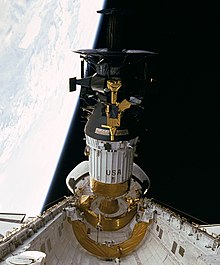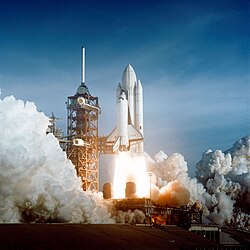STS-34
| Missionsemblem | |||
|---|---|---|---|
 | |||
| Missionsdaten | |||
| Mission | STS-34 | ||
| NSSDCA ID | 1989-084A | ||
| Besatzung | 5 | ||
| Start | 18. Oktober 1989, 16:53:40 UTC | ||
| Startplatz | Kennedy Space Center, LC-39B | ||
| Landung | 23. Oktober 1989, 16:33:01 UTC | ||
| Landeplatz | Edwards Air Force Base, Bahn 23 | ||
| Flugdauer | 4d 23h 39m 21s | ||
| Erdumkreisungen | 79 | ||
| Bahnhöhe | 343 km | ||
| Bahnneigung | 34,3° | ||
| Zurückgelegte Strecke | 3,22 Mio. km | ||
| Nutzlast | Galileo | ||
| Mannschaftsfoto | |||
 v. l. n. r. Shannon Lucid, Donald Williams, Franklin Chang-Diaz, Michael McCulley, Ellen Baker | |||
| ◄ Vorher / nachher ► | |||
| |||
STS-34 (englisch Space Transportation System) ist eine Missionsbezeichnung für das US-amerikanische Space Shuttle Atlantis (OV-104) der NASA. Der Start erfolgte am 18. Oktober 1989. Es war die 31. Space-Shuttle-Mission und der 5. Flug der Raumfähre Atlantis.
Die Mission sollte bereits im Mai 1986 von der Atlantis unter der Bezeichnung STS-61-G durchgeführt werden, wurde jedoch aufgrund der Challenger-Katastrophe ausgesetzt.
Mannschaft
- Donald Williams (2. Raumflug), Kommandant
- Michael McCulley (1. Raumflug), Pilot
- Franklin Chang-Diaz (2. Raumflug), Missionsspezialist
- Shannon Lucid (2. Raumflug), Missionsspezialistin
- Ellen Baker (1. Raumflug), Missionsspezialistin
Die Besatzung der Mission STS-61-G, bestehend aus David Walker, Ronald Grabe, Norman Thagard und James van Hoften, wurde komplett ersetzt.
Missionsüberblick

Das ursprünglich vorgesehene Startdatum vom 12. Oktober konnte nicht eingehalten werden, weil die Steuerung eines Haupttriebwerks ausgewechselt werden musste. Ein neuer Versuch am 17. Oktober scheiterte an den Witterungsverhältnissen auf dem Notlandeplatz in Cape Canaveral.
Die Hauptnutzlast bei dieser Mission war die Jupitersonde Galileo. Sie wurde zusammen mit der Raketenoberstufe Inertial Upper Stage (IUS) im Weltraum ausgesetzt. Weiterhin gehörten Experimente zur Erderkundung, Umweltforschung, Materialtechnologie, Astronomie und Medizin zu dieser Mission, und eine IMAX-Kamera war ebenfalls an Bord.
Die Landung erfolgte am 23. Oktober in Edwards AFB, Kalifornien. Atlantis wurde 6 Tage später mittels eines Spezialflugzeuges nach Cape Canaveral, Florida zurücktransportiert.
Filmaufnahmen der Mission wurden im Science-Fiction-Film The Wild Blue Yonder von Werner Herzog verwendet.
Siehe auch
Weblinks
- NASA-Missionsüberblick (englisch)
- Videozusammenfassung mit Kommentaren der Besatzung (englisch)
- STS-34 in der Encyclopedia Astronautica (englisch)
Auf dieser Seite verwendete Medien
STS-34 Mission Insignia
The April 12 launch at Pad 39A of STS-1, just seconds past 7 a.m., carries astronauts John Young and Robert Crippen into an Earth orbital mission scheduled to last for 54 hours, ending with unpowered landing at Edwards Air Force Base in California.
The STS-34 crew portrait includes 5 astronauts. Pictured left to right are Shannon W. Lucid, mission specialist; Donald E. Williams, commander; Franklin R. Chang-Diaz, mission specialist; Michael J. McCulley, pilot; and Ellen S. Baker, mission specialist. The crew of 5 launched aboard the Space Shuttle Orbiter Atlantis on October 18, 1989 at 12:53:40pm (EDT). The primary payload was the Galileo Jupiter Spacecraft and attached inertial upper stage (IUS). Deployed 6 hours and 30 minutes into the flight, the IUS stages fired, boosting Galileo on trajectory for a 6 year trip to Jupiter.
Galileo probe deployed.
- This photograph was taken by the STS-34 crew aboard the Space Shuttle Atlantis and shows the Galileo spacecraft being deployed on Oct. 18, 1989 from the payload bay. Galileo is a scientific craft that will go into orbit around the planet Jupiter and drop a probe into its atmosphere in search of primordial solar system material believed to be present there. The 70mm motion picture film will be used in the forthcoming "Blue Planet," which will address Earth's environmental problems from the perspective of space-based observation and solar system exploration. The film is being produced by IMAX Space Technology Inc. for the sponsor, the Smithsonian Institution, with funding provided by the Lockheed Corporation.




